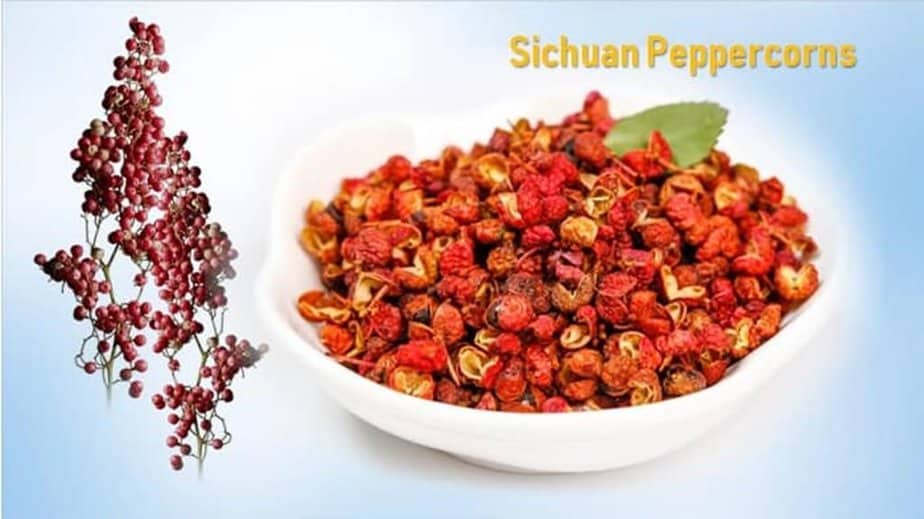Sichuan cuisines also spelled as Szechuan or Szechwan cuisines, get their deep and rich flavors from the Sichuan peppercorns. This hot pepper is the essence of popular Sichuan dishes like Fuqi Fei Pian, Sichuan Hot Pot, Dandan Mian, and a few others.
Sichuan peppercorn is a spice formed from the husks of seeds of the prickly ash shrub, is native to China and Taiwan. This article unravels the best Sichuan peppercorn substitutes that you can use.
Best Sichuan Peppercorn Substitutes
Most foodies love to gorge on spicy, hot Sichuan dishes. This pinkish peppercorn is a key ingredient in many recipes like kung pao chicken and Sichuan noodles. Some use it as a flavor alternative to the regular black pepper. However, most people don’t have access to this peppercorn outside China; also it’s expensive. In a pinch, you may use one of the Sichuan pepper alternatives listed below:
1. Tasmanian pepper
The Tasmanian pepper is mostly found in some parts of Australia, and it’s wild-harvested only on the island of Tasmania.
Tasmanian pepper is neither related to Szechuan pepper nor belongs to the piper nigrum family. This aromatic pepper has a wonderful flavor that tastes like a blend of fennel and juniper. Its floral and woody notes are quite identical to Szechuan peppercorns.
Just like the Sichuan pepper, it’s an excellent spice mate for meat dishes for rendering a floral, pungent note. Tasmanian pepper is popularly used in emu burgers and other Australian bush foods just as how Szechuan pepper is used in Sichuan cuisines.
Use Tasmanian pepper in a 1:1 substitute for Szechuan peppercorns.
2. Grains of Paradise
Grains of Paradise, also known as alligator pepper or melegueta pepper, is a species in the ginger family, Zingiberaceae, and closely related to cardamom. This spice is a popular ingredient in several North African cuisines.
The seeds have a woody, piney aroma and a warm, peppery taste. The taste is almost like a combination of cardamom and black pepper with a hint of a mild citrusy note. It’s now being increasingly used as a pepper alternative, though they don’t have the harshness of most peppercorns.
The flavor profile of Grains of Paradise has the most characteristics of Szechuan pepper. Being milder in flavor, use grains of paradise in twice the amount of Szechuan pepper required in your recipe.
3. Tellicherry pepper
Originally, the black peppercorns from Thalassery (previously Tellicherry), a township in the state of Kerala in India were known as Tellicherry peppercorns. At present, a Tellicherry peppercorn is actually determined by size; if a black peppercorn is 4.25 mm pinhead or larger, it’s a Tellicherry peppercorn regardless of where they are sourced.
These berries have a strong spicy and fruity fragrance of fresh corn husks and a hint of citrus with a classic pepper heat. Flavor-wise, this peppercorn can be a decent stand-in for Szechuan pepper.
Use Tellicherry peppercorns as a 1:1 substitute for Sichuan pepper.
4. Black Pepper
Black pepper is not a perfect Sichuan alternative but will certainly work in for some dishes. Especially, the fresh black peppercorns have a strong aroma and higher intensity of flavor that somewhat matches the fruity and earthy flavor of Sichuan peppercorns.
Some chefs advocate the use of a combination of fresh black peppercorns and coriander seeds to mimic the flavor profile of the Szechuan pepper.

Frequently Asked Questions
What is the difference between peppercorns and Sichuan peppercorns?
Szechuan peppercorns cause a tingling or numbing effect in the mouth but black peppercorns do not have any such a phenomenon. Black pepper is spicier than Sichuan peppercorns. They also differ in their use; Szechuan pepper is mostly used only in Szechuan cuisine, and black pepper is part of almost every cuisine across the world.
Are Szechuan and Sichuan the same?
Sichuan, Szechuan, or Szechwan, all these names refer to the same thing. Sichuan cuisine is a unique food that originates from Sichuan Province, China. They are different because on the key ingredient in this cuisine is the Sichuan Peppercorns.
Are pink peppercorns the same as Sichuan?
Pink peppercorns are actually the fruit of the Baies rose plant, a small tree native to South America. Szechuan peppercorns come from an entirely different plant, a type of prickly ash shrub native to northern China and Taiwan.
Is Wild pepper Sichuan pepper?
The term wild pepper is a generic term that can refer to any pepper or chili that grows the wild. The Mah Kwan wild pepper that grows in northern Thailand is somewhat similar to Sichuan and Sansho peppers. A tingling or numbing effect and peppery heat is common to all of them. Mah Kwan peppers are used in noodles, meat salads, and curries in Chiang Mai, Thailand.
Is prickly ash the same as Sichuan peppercorn?
Prickly ash (Zanthoxylum) is an evergreen tree that grows around the world. Some verities of the Prickly ash trees produce pepper-like fruits used in cooking. The most popular prickly ash peppers are Sichuan and Sansho peppercorns. The Sichuan peppercorns are often labeled as Chinese prickly ash and Sansho pepper is called Japanese prickly ash. Prickly ash is lightly peppery and leaves a lingering but gentle, numbing sensation on the tongue. They aren’t actually true peppercorns but only the berries of prickly ash trees.
Is Chinese red pepper the same as Sichuan pepper?
The Chinese red pepper and Sichuan peppers are one and the same. Sichuan peppercorns are known in different names like Szechwan pepper, Chinese pepper, rattan pepper (name for the green variety), dehydrated prickly ash, pink prickly ash, and mala pepper.
Final Thoughts
Sichuan peppercorn produces a tingling, numbing effect on the tongue with a hot and spicy flavor. This peppercorn is the soul of many of the popular Sichuan cuisines.
If you don’t have Szechuan pepper, the best alternative to use is the Tasmanian pepper. The second-best substitutes for Sichuan pepper are Tellicherry pepper and Grains of Paradise.
For further reading, have a look at the best White Pepper substitutes that you can choose for your recipe.
